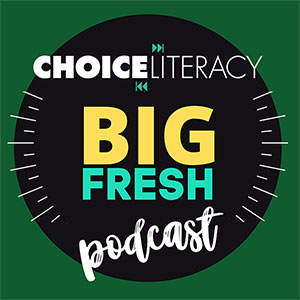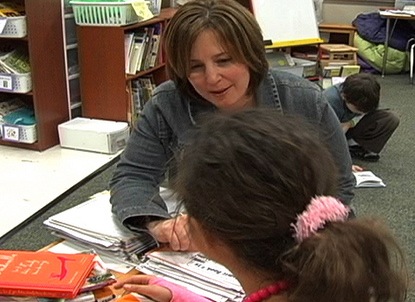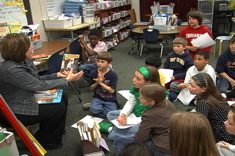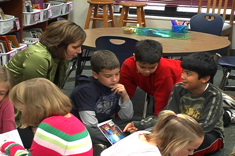In this podcast, Sharon Taberski talks with Franki Sibberson about how she selects books for instruction, as well as how she assists students as they make choices for independent reading. Sharon also shares some of her favorite books for instruction and independent reading.
A full transcript of the podcast is available below the player.


Franki Sibberson: Sharon, when you think about book choice, how do you choose fiction books for comprehension teaching?
Sharon Taberski: Well, I guess first of all, I need to say whether I’m looking for fiction books or informational text to use with kids, I look first for the books that kids will love. Books that I love and books that kids will love, because I’m intending to read this book once, twice, several times, and I hope that it’s going to be a book that they’re going to reach for many times after that, so it should be one that they love. Kids have to be engaged before they learn, so it’s not that I choose a book because it’s a particularly good book for a comprehension strategy or comprehension teaching.
I choose it because I love it and the kids will too, and then I look at the book for how it can further their comprehension. There are times, you know, like in second and third grade, when I do want kids to focus on a particular strategy, comprehension strategy, over the course of two or three weeks, and so in that case I would want a couple of books on hand that would support those specific strategies. But in general, my book choice for fiction and nonfiction is expansive, like my view of comprehension instruction.
I don’t just look to the strategies; I look for how am I gonna develop kids’ oral language and vocabulary, how am I gonna help them see reading/writing connections, how am I going to help them acquire and use background knowledge, and what about phrasing and accuracy and fluency – and also, what about the strategy? So when I pick books, it has to address these issues, so I’m not just looking for strategy books when I’m thinking about comprehension. I mean I think a really good example – a book that I love is an old book, Roger DuVoisin’s Donkey-Donkey, and it’s a book that kids love.
It’s a very typical, standard structure, but the words in that book that kids are exposed to are just outrageous. I mean just amazing, when you look at it, word for word, and say, “Oh my gosh, when I read that book to those children they’re being exposed to these words over and over again.” And these are Isabel Beck and McCune and Coogan’s tier two words – that’s basically what they are – and I’m still exposing them, and maybe highlighting some and focusing on them. But to me, that’s teaching comprehension, because you can’t comprehend any book unless you know about 95 percent of the words.
And so, you know, you just have to broaden your idea of what it means to comprehend; strategies are good, but so is knowing the vocabulary words. You know, there are books that help start up conversations with students. Like a really good book – this is a fiction book, and they both are, actually – well, I think The Goat Lady is based on a true story. The Goat Lady
by Jane Bregoli, and then I like to set with a companion, Beatrice’s Goat
. I mean it’s an amazing story about an old woman who lives in the country, and she keeps goats on her farm.
And she’s not taking care of her farm, or so the people think, and the neighbors don’t like her. But it’s how this little girl gets inside the home and learns to know her, and how soon the whole community knows her. Now, it’s a great – what she’s done, though, is she’s sending these goats that she has, extra goats, to the Heffner Fund, and they’re sending them to places in third-world countries to help them get started with their own better way of living. And so it’s just a gorgeous book to talk about; the language is beautiful, the writing is beautiful.
It’s wonderful to make inferences about is she happy? How could she be? But look at her – she’s smiling. And then to see that here’s another book, called Beatrice’s Goat, where the goat ends up – a goat – ends up in Africa, and how it really provides the opportunity for this little girl to go to school. So I think books like that, it’s just they’re so much bigger than strategies, but yet the strategies, when you come down to talking with the kids and reading with them and writing with them, the strategies are certainly there to use as and if you need to.
Franki: Okay, and what about nonfiction? How do you choose nonfiction books for comprehension teaching?
Sharon: Well, I’m looking for nonfiction books, in general: for books that are attractive, books that are accurate, and books that are accessible. And it’s becoming easier and easier to meet these requirements these days; I mean, thank goodness, there’s so many more informational texts on the market that we can choose from. I mean it has to be attractive. I mean even it was even a little bit nuts in my classroom.
I work so hard to make it look good, but that’s just really important to me, and I think it’s important to children, to have beautiful books in their hands that are colorful, that pop. And it just makes the whole reading experience so much more something that you want to do. The book needs to be accurate: it needs to be written by somebody who’s knowledgeable in the field, and I think it’s good, you know, critical thinking tool for children to understand that they do need to look up the author, and see the author’s point of view.
Are they trying to put something across that they’re not obvious about? Are they being accurate in their information? And so, you know, it’s important to look at the author who’s written the book, and, you know, when you see inconsistencies between books, it’s fun to investigate. Like who’s right, and why did one person say one thing, and one another? And then the material has to be accessible. You know, the text features and the access features have to invite children in to get the information: the scale drawings, the tables of contents, the indexes, the sidebars.
I mean all of that helps a reader get the information that they’re looking for and need to learn, so I mean basically, that’s important. And then you always wanna know the topics your kids are interested in, and the topics that are in the curriculum. I think it’s gonna be interesting when the common core standards in science and social studies come out; I believe they’re supposed to be out this year. I could be wrong, but I think so, because you’re gonna see topics develop across the years.
And I think it’s going to be fun to pick books in kindergarten, first, second, for example, about the body and the senses, and then see how that grows into later years, into the body circulatory system. And just to see how we’re building information, because I do think it is important to build, and I don’t think our kids are building now – they’re kinda like all over the place. So I think that will be something that will help us pick books, to know the common topics that we should be addressing, but not inflexibly – in a way that makes sense to our children and our school in a particular year.
Franki: Sharon, you mentioned a few books. Are there any other favorite books that you use for comprehension teaching?
Sharon: Well, there’s a lot of books. As I said before, you know, I don’t look for the book just because it’s a good strategy book; I look for it because it’s just a plain, good book. And I know that I can apply strategies throughout, because that’s the kind of book it is. You know, some of my favorites – you know, I do love The Birthday Fish by Dan Yaccarino. I think it’s a great book for discussing with kids and perspective-taking, like for example, the end of the book, you know – did it turn out happy?
Well, the little girl got what she wanted, but then what about the fish? He never got returned to the river or the stream, like he wanted all along. I love if you wanna talk specifically about a metacognitive strategy, like visualizing, I think that Brave Irene by William Steig is a wonderful book. The language is outstanding, and the word choice is, you know, to drop dead for – I mean I couldn’t imagine writing like he does, putting words together like that. And I think it’s a wonderful book to say, “Look at what he did. Do you believe what he did? Let’s examine what he did.”
Another book, for example, that’s really good for thinking about characters is Laura Numeroff’s The Chicken Sisters. You know, there’s three chicken sisters, Violet, Poppy, and Babs, and they’re all very different, and it’s because of how they are, their characteristics, that the story turns out like it did. So I think, even at the very early grades, you can show children, “Oh my gosh, pay attention to what the characters are like,” because it had everything to do with how this story turned out. Another great book is Sunshine Home
by Eve Bunting.
It’s a story about a little boy going to visit his grandmother in the nursing home for the first time, and a lot of inferring has to take place. The boy’s noticing how his mother’s voice changes, and he’s just noticing how different people and his grandmother are acting differently, and he’s trying to put it together for what this means, so you have to really be thinking and figuring out. You know, using what the author’s telling you and your own experiences to come to a new conclusion. You know, I love the book The Forever Dog by Bill Cochran.
It’s just a beautiful book about a little boy and his dog, and it’s great because it has like one daytime, and every daytime, I mean every daytime first, every day they’re like this, and then one day, it gives a lot of examples about how they played together. It didn’t just say, “They played together,” but as you turn the pages, you see little pictures, vignettes, about different things that they did. There’s a lot of main idea and details in there. There’s even flashbacks in the sense of remembering things that he did with his dog later on, so that’s a lovely book to talk about too.
And you know, probably my all-time favorites in terms of talking about character and story structure are Rosemary Wells, I mean her basic books:Timothy Goes to School, Noisy Nora
, Shy Charles
, Doris’s Dinosaur
. And then reading it alongside with Timothy’s Tales From Hilltop School
, which is a collection of about five or six short stories, and it’s just so cool to see children who know the characters by being read aloud the picture book – how they can really appreciate Rosemary Wells’ writing when she writes about these same characters in the same way.
So I mean books are wonderful these days, and you, of all people, know the great books, and I kind of envy that a lot, because I wish I knew more, but I’m getting better.
Franki: Okay, what’s that last one called?
Sharon: The last one is called Timothy’s Tales From Hilltop School.
Franki: And that’s Rosemary Wells.
Sharon: Yeah – it’s drop-dead funny.
Franki: Oh – okay.
Sharon: It’s especially funny if you know the characters, though. That’s the thing.
Franki: You have to know the characters first.
Sharon: If you don’t know her picture books, and you don’t know that Nora is really loud, or that Charles is always trying to hide and not be heard –
Franki: Oh, so it’s all the characters together.
Sharon: It’s all the characters together from all her books.
Franki: I love that.
Sharon: It’s members of this class, and they’re consistent throughout. I mean it’s just really, really good.
Franki: How do you use student independent reading to support comprehension?
Sharon: Well, I guess the only thing I can say – because I’m not really sure how to address that question – is that we need to be a whole lot more careful about the books we put in children’s hands for independent reading. From what I’ve seen, in many, many, many cases the kids can’t read or understand the books that are in the bags – they’re just simply too hard for them. There’s kids going off on a particular day of the week and shopping for books that happen to be in their level basket.
And if you really sit with the child or those children and see what they’ve selected and what’s in those books, very, very often they can’t read them. And so they’re probably not making good use of their independent reading time, and if they’re not reading the words, they’re not understanding the story. And likewise, if the books are never changed, then the books are gonna be too easy and there’s not gonna be any growth that happens. So it has to be a balance.
I mean, Richard Allington says that children, for independent reading, need to be able to read the book with about 98 to 99 percent word accuracy, and that’s really hard to do. I know even in my own classroom here, I looked at my kids – I mean, you know, it’s really hard to keep it something like that, but it’s so important to do. On the other hand, you also need to have in their bag look books, which are – it’s pretty obvious what that is. They’re books, informational texts, for example, that they can’t read independently the words, but they can look at the pictures, and they can gain information like that.
And I think it’s also important for them to have a couple of easy books; just kind of like warm-up books – books to kind of go back to because they either love the book, or it’s just a book that they kind of like start each day off by reading. And so – but I think in general, they’ve gotta be really careful. I think our independent reading time is one of the most important times of the day, and it’s really important that it not be a stand-alone. It’s not like, “Okay, we’re just gonna go off and read.” Careful thought has to be given to, you know, the kinds of book that kids are reading, and how are we going to scaffold their independent reading during this time?
Are they gonna work with partners first, for the first 15 minutes – a stronger partner and a weaker partner, together, and then go off and read books on their own? You know, is the teacher going to introduce some of these books during the reading conferences? You know, we have to make sure that they really know their guided reading books, so that when these books land in their bag, they’re books that they can read. So it’s just independent reading is so connected with all other parts of the workshop, we’ve gotta be really careful that we’re putting the right books in kids’ hands.
Franki: Often, with new readers, the books that they read do not often lead to higher level comprehension – the ones that they’re reading on their own. How do you support comprehension learning where the kids are reading books that have simpler text?
Sharon: Well, I think that, basically this is where the interactive read-aloud comes into play. You know, the comprehension learning and teaching occurs when the teacher is reading aloud to the children and showing the children what they do and introducing vocabulary and posing questions. And so we can engage them in the deep thinking about a book; I mean that’s really the comprehension piece, is the deep thinking that happens.
You know, even though the book that they’re reading isn’t necessarily the kind of book that’s going to lend itself to this deep thinking, you know, it’s gonna help them envision and participate collectively in what good readers do when they read. An excellent, excellent article about repeated independent reading is one called “Repeated Interactive Read-Alouds in Preschool and Kindergarten,” and that’s by Lea McGee and Judith A. Schickedanz, and it just offers so many smart ideas for reading aloud to younger students.
And I just have to say that I don’t believe it’s just for pre-K and K – I think first grade teachers, second grade teachers, ELL students would all do well to read the article and learn what the authors have to say about how we can scaffold children’s thinking and question asking and answering by doing just a few simple things.
Franki: Sharon, how do you best support readers in comprehension as they move from picture books to chapter books?
Sharon: Well, you know, I think that second and third grade is really a time where the focused comprehension strategy instruction begins, or where we’re kind of like letting them go off and work on things on their own. And this is kind of where the chapter books come into play, because before that, they’re using so much of their brain capacity on figuring out what the words are; I mean it’s really overloading them to think also of, you know, other, more metacognitive processes as well.
And I just finished reading a book a couple days ago – it was called Comprehension Connections: Bridges to Strategic Reading, by Tanny McGregor. And it’s a book I’ve had on my shelf for quite a while, and I’ve never really gotten around to reading it, and I think it was a really interesting and really important book, because she talks about ways – talks about the strategies, the metacognitive strategies, per se. But she talks about them in a very, very concrete way, by demonstrating to children what they mean by using concrete, everyday objects.
A salad bowl, you know, small salad bowls and a mixing bowl, and having kids mix the facts together. And I’m not gonna do it justice, but just a lint remover picking up all the bits, all the things that have happened in their life, and showing them that this is what is in their brain to use, you know, when they’re reading new information. But it was powerful because it was concrete, and I can remember them because it was so concrete, and I think that that might be what is missing for children, at least at the beginning, is that we’re talking about things that they can’t see or touch or feel.
Yet if we make them concrete somehow, this’ll really give them a leg up. They won’t need that kind of scaffold later on, but at least they’re gonna have that picture in their mind. “Oh yeah, when she showed me that strategy, this is what it means.” And I think that more like this – and you know that I’m not a cutesy kind of teacher; I don’t go in for a lot of that cute stuff – but this is something that I really opened my eyes and said, “Wow, she’s really onto something.”
It made it memorable, and it made it concrete, and I think that that’s what has to happen, because the picture books are so concrete in the sense that you see what’s happening – the good ones, anyway. The author and the illustrator work so closely to show you. But then when you get to the chapter books, it’s really the words, and you’ve gotta make a picture in your mind about what the words are saying. And we’re making children work really, really hard to apply a strategy, and in this instance, showing them concretely what we mean might be something that’s needed.
And I mean I haven’t tried it myself, but it’s something that I would certainly try; I mean I used charts, and I used strategy sheets to show them, and large posters, but I think that something as concrete as this would be a good thing to do, too.







